warning SKODA YETI 2011 1.G / 5L Workshop Manual
[x] Cancel search | Manufacturer: SKODA, Model Year: 2011, Model line: YETI, Model: SKODA YETI 2011 1.G / 5LPages: 252, PDF Size: 3.61 MB
Page 68 of 252
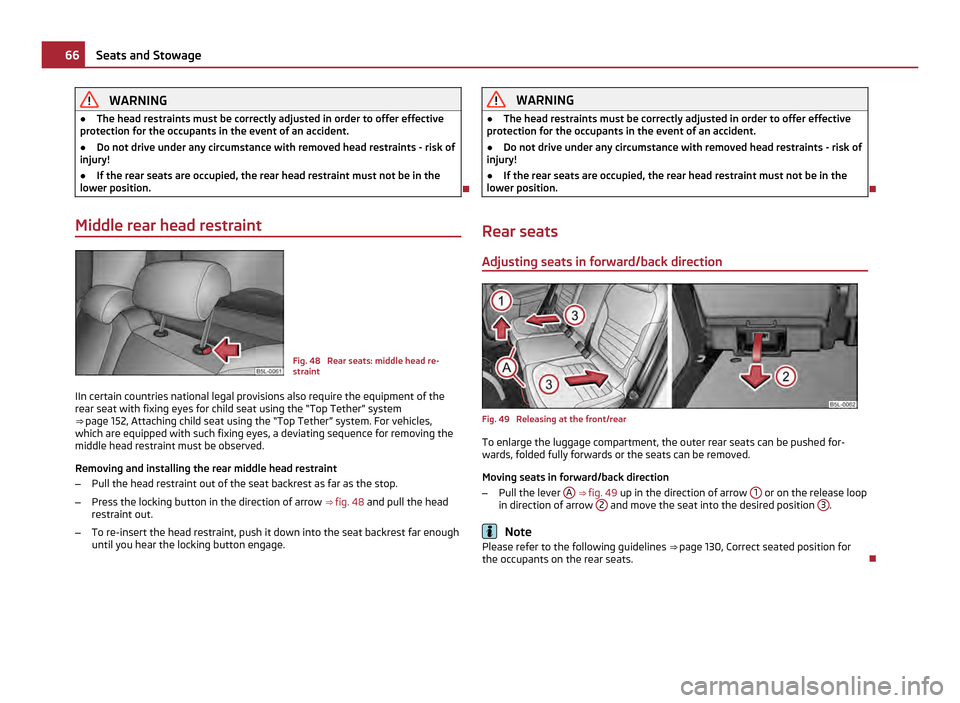
WARNING
● The head restraints must be correctly adjusted in order to offer effective
protection for the occupants in the event of an accident.
● Do not drive under any circumstance with removed head restraints - risk of
injury!
● If the rear seats are occupied, the rear head restraint must not be in the
lower position.
Middle rear head restraint Fig. 48 Rear seats: middle head re-
straint
IIn certain countries national legal provisions also require the equipment of the
rear seat with fixing eyes for child seat using the “Top Tether” system
⇒ page 152, Attaching child seat using the “Top Tether” system. For vehicles,
which are equipped with such fixing eyes, a deviating sequence for removing the
middle head restraint must be observed.
Removing and installing the rear middle head restraint
– Pull the head restraint out of the seat backrest as far as the stop.
– Press the locking button in the direction of arrow ⇒
fig. 48 and pull the head
restraint out.
– To re-insert the head restraint, push it down into the seat backrest far enough
until you hear the locking button engage. WARNING
● The head restraints must be correctly adjusted in order to offer effective
protection for the occupants in the event of an accident.
● Do not drive under any circumstance with removed head restraints - risk of
injury!
● If the rear seats are occupied, the rear head restraint must not be in the
lower position.
Rear seats Adjusting seats in forward/back direction Fig. 49 Releasing at the front/rear
To enlarge the luggage compartment, the outer rear seats can be pushed for-
wards, folded fully forwards or the seats can be removed.
Moving seats in forward/back direction
– Pull the lever A
⇒ fig. 49 up in the direction of arrow 1 or on the release loop
in direction of arrow 2 and move the seat into the desired position
3 .
Note
Please refer to the following guidelines ⇒
page 130, Correct seated position for
the occupants on the rear seats. 66
Seats and Stowage
Page 69 of 252
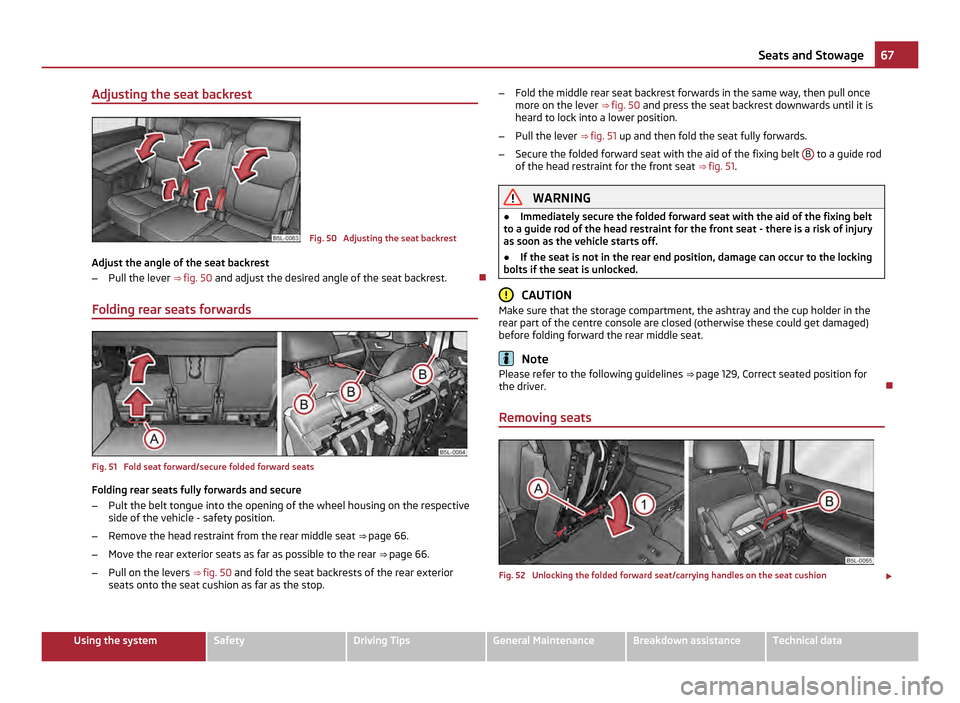
Adjusting the seat backrest
Fig. 50 Adjusting the seat backrest
Adjust the angle of the seat backrest
– Pull the lever ⇒ fig. 50 and adjust the desired angle of the seat backrest.
Folding rear seats forwards Fig. 51 Fold seat forward/secure folded forward seats
Folding rear seats fully forwards and secure
–
Pult the belt tongue into the opening of the wheel housing on the respective
side of the vehicle - safety position.
– Remove the head restraint from the rear middle seat ⇒ page 66
.
– Move the rear exterior seats as far as possible to the rear ⇒
page 66.
– Pull on the levers ⇒ fig. 50 and fold the seat backrests of the rear exterior
seats onto the seat cushion as far as the stop. –
Fold the middle rear seat backrest forwards in the same way, then pull once
more on the lever ⇒
fig. 50 and press the seat backrest downwards until it is
heard to lock into a lower position.
– Pull the lever ⇒
fig. 51 up and then fold the seat fully forwards.
– Secure the folded forward seat with the aid of the fixing belt B to a guide rod
of the head restraint for the front seat ⇒ fig. 51. WARNING
● Immediately secure the folded forward seat with the aid of the fixing belt
to a guide rod of the head restraint for the front seat - there is a risk of injury
as soon as the vehicle starts off.
● If the seat is not in the rear end position, damage can occur to the locking
bolts if the seat is unlocked. CAUTION
Make sure that the storage compartment, the ashtray and the cup holder in the
rear part of the centre console are closed (otherwise these could get damaged)
before folding forward the rear middle seat. Note
Please refer to the following guidelines ⇒
page 129, Correct seated position for
the driver.
Removing seats Fig. 52 Unlocking the folded forward seat/carrying handles on the seat cushion
£ 67
Seats and Stowage Using the system Safety Driving Tips General Maintenance Breakdown assistance Technical data
Page 70 of 252
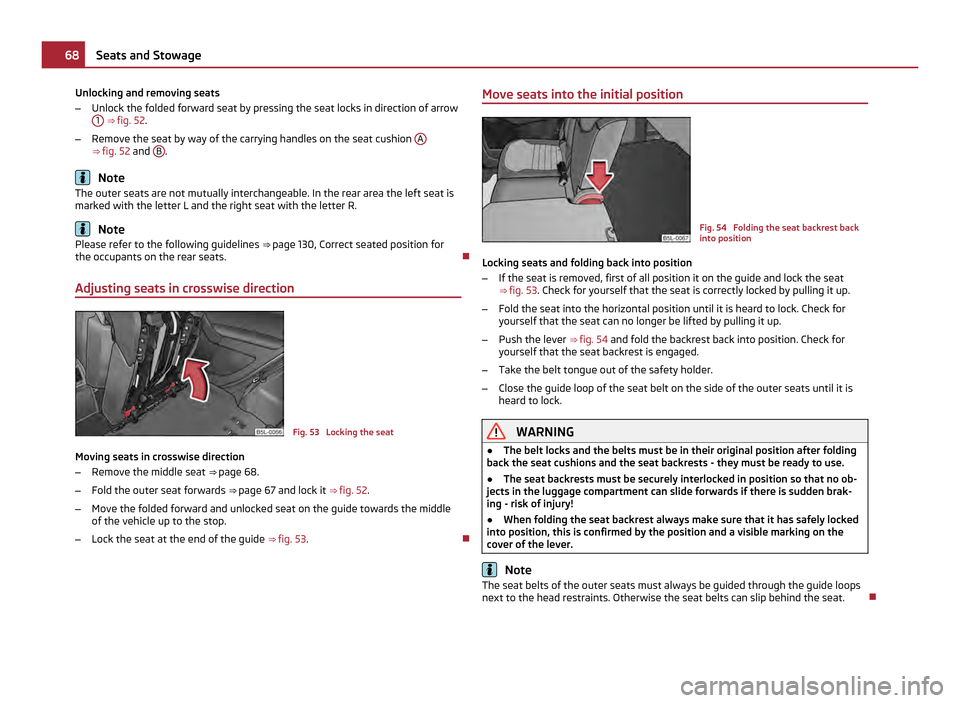
Unlocking and removing seats
–
Unlock the folded forward seat by pressing the seat locks in direction of arrow
1 ⇒ fig. 52
.
– Remove the seat by way of the carrying handles on the seat cushion A⇒ fig. 52
and B .
Note
The outer seats are not mutually interchangeable. In the rear area the left seat is
marked with the letter L and the right seat with the letter R. Note
Please refer to the following guidelines ⇒ page 130, Correct seated position for
the occupants on the rear seats.
Adjusting seats in crosswise direction Fig. 53 Locking the seat
Moving seats in crosswise direction
– Remove the middle seat ⇒ page 68
.
– Fold the outer seat forwards ⇒ page 67 and lock it ⇒
fig. 52.
– Move the folded forward and unlocked seat on the guide towards the middle
of the vehicle up to the stop.
– Lock the seat at the end of the guide ⇒
fig. 53 . Move seats into the initial position
Fig. 54 Folding the seat backrest back
into position
Locking seats and folding back into position
– If the seat is removed, first of all position it on the guide and lock the seat
⇒ fig. 53 . Check for yourself that the seat is correctly locked by pulling it up.
– Fold the seat into the horizontal position until it is heard to lock. Check for
yourself that the seat can no longer be lifted by pulling it up.
– Push the lever ⇒ fig. 54 and fold the backrest back into position. Check for
yourself that the seat backrest is engaged.
– Take the belt tongue out of the safety holder.
– Close the guide loop of the seat belt on the side of the outer seats until it is
heard to lock. WARNING
● The belt locks and the belts must be in their original position after folding
back the seat cushions and the seat backrests - they must be ready to use.
● The seat backrests must be securely interlocked in position so that no ob-
jects in the luggage compartment can slide forwards if there is sudden brak-
ing - risk of injury!
● When folding the seat backrest always make sure that it has safely locked
into position, this is confirmed by the position and a visible marking on the
cover of the lever. Note
The seat belts of the outer seats must always be guided through the guide loops
next to the head restraints. Otherwise the seat belts can slip behind the seat. 68
Seats and Stowage
Page 71 of 252

Folding table on the middle seat backrest
Fig. 55 Rear seats: Armrest
– The middle seat backrest can be folded ⇒ page 67, Folding rear seats forwards
forwards and used as armrest or table with cup holder ⇒ fig. 55 .
– You can place two cups or beverage cans into the recesses. WARNING
● Do not place any hot beverages into the cup holder. If the vehicle moves,
they may spill - risk of scalding!
● Do not use any cups or beakers which are made of brittle material (e.g.
glass, porcelain). This could lead to injuries in the event of an accident. CAUTION
Do not open the beverages in the cup holder while driving. There is a risk of spill-
ing e.g. when braking and therefore the electrical components or the seat uphols-
tery can be damaged. Note
If the middle rear seat backrest should be folded forward for lengthy periods, then
make sure that the belt locks are not located below it - this can result in perma-
nent damage to the upholstery. Seat heating of the front seats Fig. 56 Dash panel: Regulator for front
seat heating
You can electrically heat the seat cushions and the seat backrests of the front
seats.
Front seats
– You can switch on and regulate the seat heating of the driver or front passen-
ger seat by pressing the surface of the regulator at the point at which the
symbol is located ⇒
fig. 56 .
– With one press, you can switch the heating to highest intensity - 3rd stage,
which is indicated by the lighting up of the three warning lights in the switch.
– With repeated pressing of the switch, the intensity of the heating is down-
regulated up to the switch-off. The intensity of the heating is indicated by the
number of illuminated warning lights in the switch. WARNING
If, as an occupant, you have a subdued pain and/or temperature sensitivity,
e.g. through medication, paralysis or because of chronic illness (e.g. diabetes),
we recommend not to use the seat heating. This can lead to burns on the
back, the posterior and the legs which are difficult to heal. If the seat heating
is used, we recommend to make regular breaks in your journey when driving
long distances, so that in specific cases as mentioned above the body can re-
cuperate from the stress of the journey. Please consult your doctor, who can
evaluate your specific condition. £ 69
Seats and Stowage Using the system Safety Driving Tips General Maintenance Breakdown assistance Technical data
Page 72 of 252
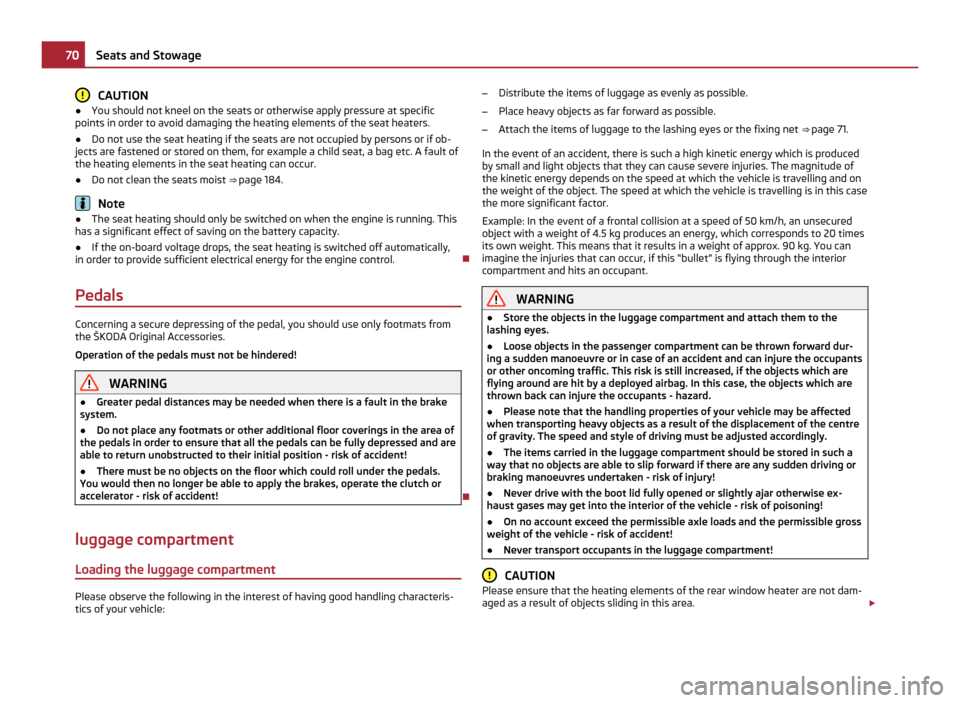
CAUTION
● You should not kneel on the seats or otherwise apply pressure at specific
points in order to avoid damaging the heating elements of the seat heaters.
● Do not use the seat heating if the seats are not occupied by persons or if ob-
jects are fastened or stored on them, for example a child seat, a bag etc. A fault of
the heating elements in the seat heating can occur.
● Do not clean the seats moist ⇒ page 184 .Note
● The seat heating should only be switched on when the engine is running. This
has a significant effect of saving on the battery capacity.
● If the on-board voltage drops, the seat heating is switched off automatically,
in order to provide sufficient electrical energy for the engine control.
Pedals Concerning a secure depressing of the pedal, you should use only footmats from
the
ŠKODA Original Accessories.
Operation of the pedals must not be hindered! WARNING
● Greater pedal distances may be needed when there is a fault in the brake
system.
● Do not place any footmats or other additional floor coverings in the area of
the pedals in order to ensure that all the pedals can be fully depressed and are
able to return unobstructed to their initial position - risk of accident!
● There must be no objects on the floor which could roll under the pedals.
You would then no longer be able to apply the brakes, operate the clutch or
accelerator - risk of accident!
luggage compartment
Loading the luggage compartment Please observe the following in the interest of having good handling characteris-
tics of your vehicle: –
Distribute the items of luggage as evenly as possible.
– Place heavy objects as far forward as possible.
– Attach the items of luggage to the lashing eyes or the fixing net ⇒
page 71.
In the event of an accident, there is such a high kinetic energy which is produced
by small and light objects that they can cause severe injuries. The magnitude of
the kinetic energy depends on the speed at which the vehicle is travelling and on
the weight of the object. The speed at which the vehicle is travelling is in this case
the more significant factor.
Example: In the event of a frontal collision at a speed of 50 km/h, an unsecured
object with a weight of 4.5 kg produces an energy, which corresponds to 20 times
its own weight. This means that it results in a weight of approx. 90 kg. You can
imagine the injuries that can occur, if this “bullet” is flying through the interior
compartment and hits an occupant. WARNING
● Store the objects in the luggage compartment and attach them to the
lashing eyes.
● Loose objects in the passenger compartment can be thrown forward dur-
ing a sudden manoeuvre or in case of an accident and can injure the occupants
or other oncoming traffic. This risk is still increased, if the objects which are
flying around are hit by a deployed airbag. In this case, the objects which are
thrown back can injure the occupants - hazard.
● Please note that the handling properties of your vehicle may be affected
when transporting heavy objects as a result of the displacement of the centre
of gravity. The speed and style of driving must be adjusted accordingly.
● The items carried in the luggage compartment should be stored in such a
way that no objects are able to slip forward if there are any sudden driving or
braking manoeuvres undertaken - risk of injury!
● Never drive with the boot lid fully opened or slightly ajar otherwise ex-
haust gases may get into the interior of the vehicle - risk of poisoning!
● On no account exceed the permissible axle loads and the permissible gross
weight of the vehicle - risk of accident!
● Never transport occupants in the luggage compartment! CAUTION
Please ensure that the heating elements of the rear window heater are not dam-
aged as a result of objects sliding in this area. £70
Seats and Stowage
Page 73 of 252
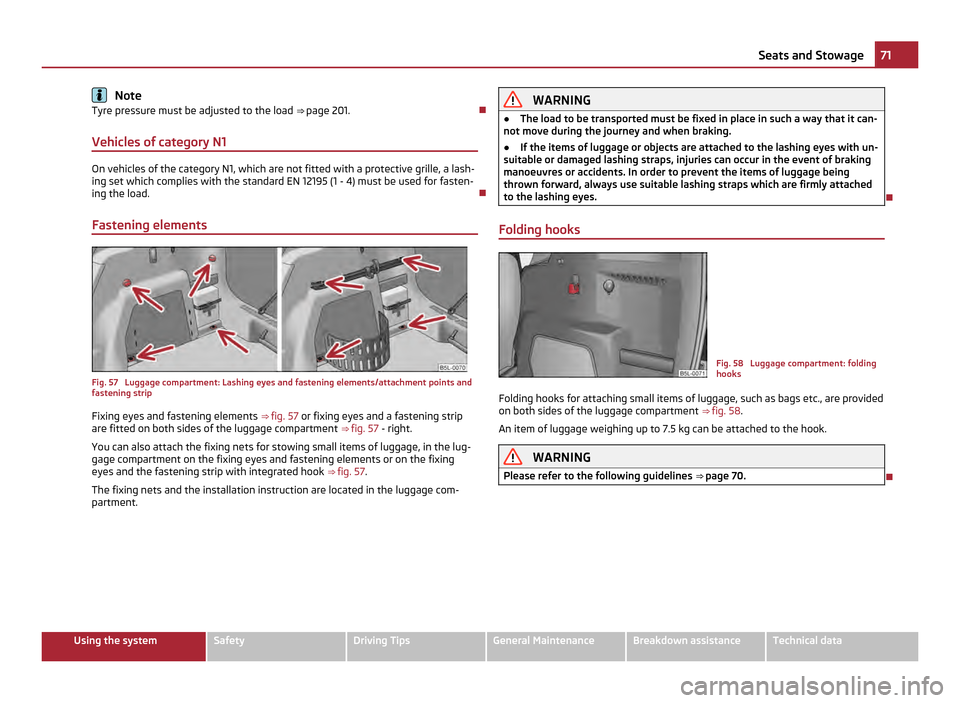
Note
Tyre pressure must be adjusted to the load ⇒ page 201.
Vehicles of category N1 On vehicles of the category N1, which are not fitted with a protective grille, a lash-
ing set which complies with the standard EN
12195 (1 - 4) must be used for fasten-
ing the load.
Fastening elements Fig. 57 Luggage compartment: Lashing eyes and fastening elements/attachment points and
fastening strip
Fixing eyes and fastening elements ⇒ fig. 57 or fixing eyes and a fastening strip
are fitted on both sides of the luggage compartment ⇒
fig. 57 - right.
You can also attach the fixing nets for stowing small items of luggage, in the lug-
gage compartment on the fixing eyes and fastening elements or on the fixing
eyes and the fastening strip with integrated hook ⇒ fig. 57.
The fixing nets and the installation instruction are located in the luggage com-
partment. WARNING
● The load to be transported must be fixed in place in such a way that it can-
not move during the journey and when braking.
● If the items of luggage or objects are attached to the lashing eyes with un-
suitable or damaged lashing straps, injuries can occur in the event of braking
manoeuvres or accidents. In order to prevent the items of luggage being
thrown forward, always use suitable lashing straps which are firmly attached
to the lashing eyes.
Folding hooks Fig. 58 Luggage compartment: folding
hooks
Folding hooks for attaching small items of luggage, such as bags etc., are provided
on both sides of the luggage compartment ⇒ fig. 58 .
An item of luggage weighing up to 7.5 kg can be attached to the hook. WARNING
Please refer to the following guidelines ⇒ page 70. 71
Seats and Stowage Using the system Safety Driving Tips General Maintenance Breakdown assistance Technical data
Page 74 of 252
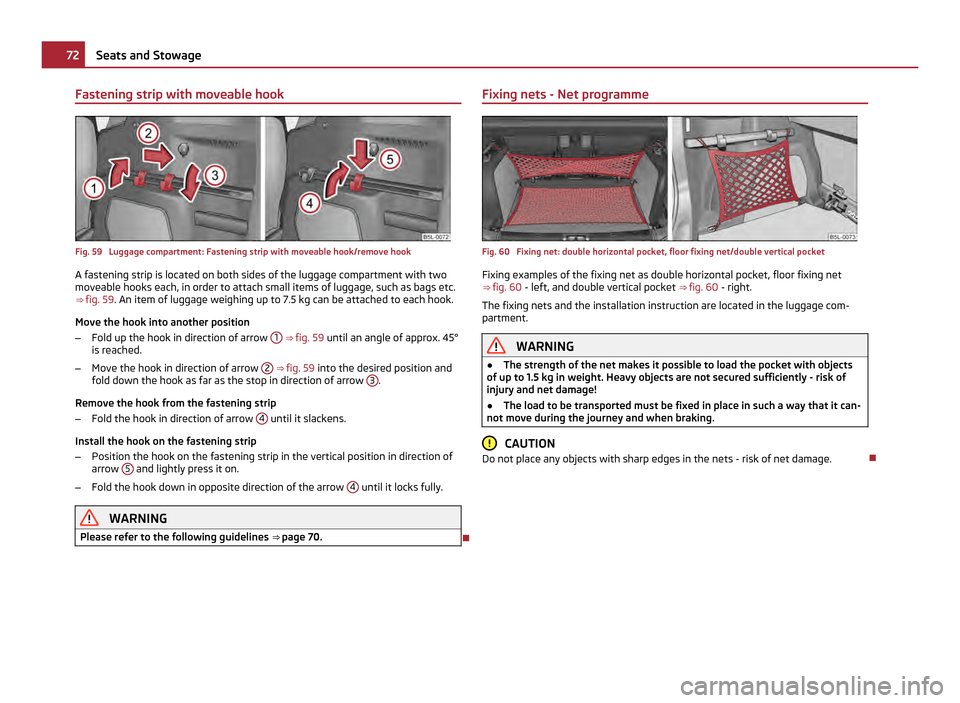
Fastening strip with moveable hook
Fig. 59 Luggage compartment: Fastening strip with moveable hook/remove hook
A fastening strip is located on both sides of the luggage compartment with two
moveable hooks each, in order to attach small items of luggage, such as bags etc.
⇒ fig. 59 . An item of luggage weighing up to 7.5 kg can be attached to each hook.
Move the hook into another position
– Fold up the hook in direction of arrow 1
⇒ fig. 59 until an angle of approx. 45°
is reached.
– Move the hook in direction of arrow 2
⇒ fig. 59 into the desired position and
fold down the hook as far as the stop in direction of arrow 3 .
Remove the hook from the fastening strip
– Fold the hook in direction of arrow 4 until it slackens.
Install the hook on the fastening strip
– Position the hook on the fastening strip in the vertical position in direction of
arrow 5 and lightly press it on.
– Fold the hook down in opposite direction of the arrow 4 until it locks fully.
WARNING
Please refer to the following guidelines ⇒ page 70. Fixing nets - Net programme
Fig. 60 Fixing net: double horizontal pocket, floor fixing net/double vertical pocket
Fixing examples of the fixing net as double horizontal pocket, floor fixing net
⇒ fig. 60 - left, and double vertical pocket ⇒
fig. 60 - right.
The fixing nets and the installation instruction are located in the luggage com-
partment. WARNING
● The strength of the net makes it possible to load the pocket with objects
of up to 1.5 kg in weight. Heavy objects are not secured sufficiently - risk of
injury and net damage!
● The load to be transported must be fixed in place in such a way that it can-
not move during the journey and when braking. CAUTION
Do not place any objects with sharp edges in the nets - risk of net damage. 72
Seats and Stowage
Page 75 of 252
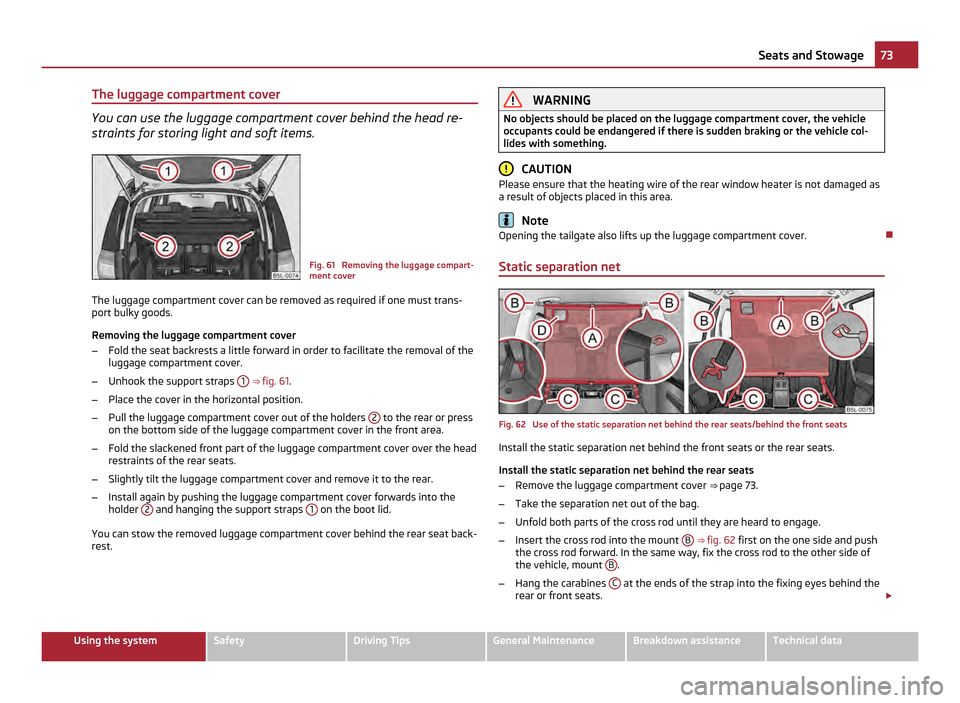
The luggage compartment cover
You can use the luggage compartment cover behind the head re-
straints for storing light and soft items.
Fig. 61 Removing the luggage compart-
ment cover
The luggage compartment cover can be removed as required if one must trans-
port bulky goods.
Removing the luggage compartment cover
– Fold the seat backrests a little forward in order to facilitate the removal of the
luggage compartment cover.
– Unhook the support straps 1
⇒ fig. 61 .
– Place the cover in the horizontal position.
– Pull the luggage compartment cover out of the holders 2 to the rear or press
on the bottom side of the luggage compartment cover in the front area.
– Fold the slackened front part of the luggage compartment cover over the head
restraints of the rear seats.
– Slightly tilt the luggage compartment cover and remove it to the rear.
– Install again by pushing the luggage compartment cover forwards into the
holder 2 and hanging the support straps
1 on the boot lid.
You can stow the removed luggage compartment cover behind the rear seat back-
rest. WARNING
No objects should be placed on the luggage compartment cover, the vehicle
occupants could be endangered if there is sudden braking or the vehicle col-
lides with something. CAUTION
Please ensure that the heating wire of the rear window heater is not damaged as
a result of objects placed in this area. Note
Opening the tailgate also lifts up the luggage compartment cover.
Static separation net Fig. 62 Use of the static separation net behind the rear seats/behind the front seats
Install the static separation net behind the front seats or the rear seats.
Install the static separation net behind the rear seats
–
Remove the luggage compartment cover ⇒ page 73.
– Take the separation net out of the bag.
– Unfold both parts of the cross rod until they are heard to engage.
– Insert the cross rod into the mount B
⇒ fig. 62 first on the one side and push
the cross rod forward. In the same way, fix the cross rod to the other side of
the vehicle, mount B .
– Hang the carabines C at the ends of the strap into the fixing eyes behind the
rear or front seats. £ 73
Seats and Stowage Using the system Safety Driving Tips General Maintenance Breakdown assistance Technical data
Page 76 of 252
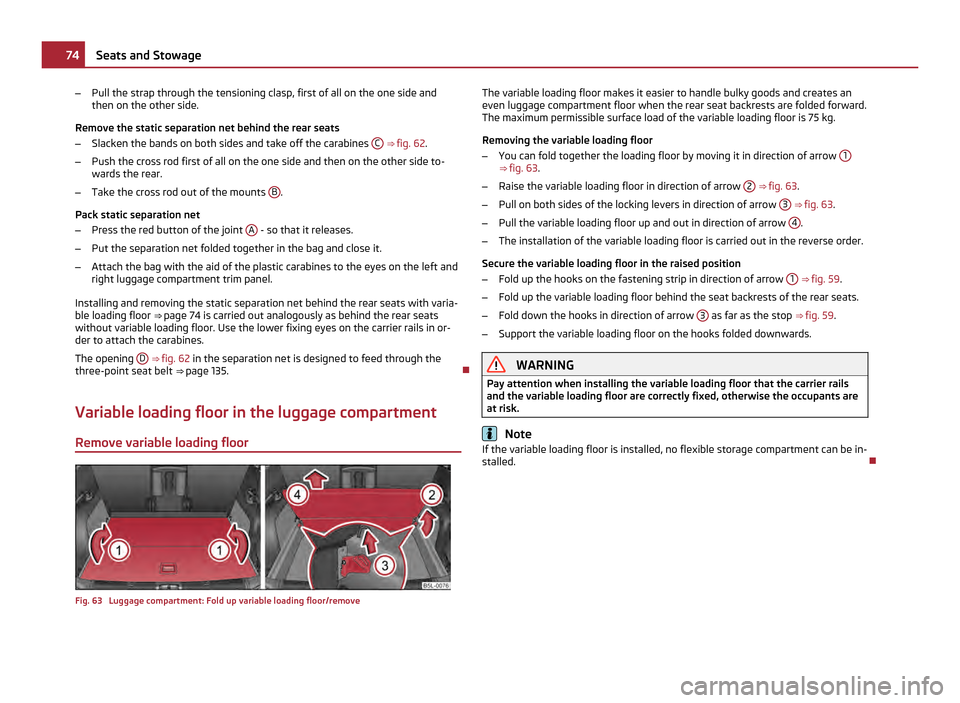
–
Pull the strap through the tensioning clasp, first of all on the one side and
then on the other side.
Remove the static separation net behind the rear seats
– Slacken the bands on both sides and take off the carabines C ⇒ fig. 62
.
– Push the cross rod first of all on the one side and then on the other side to-
wards the rear.
– Take the cross rod out of the mounts B .
Pack static separation net
– Press the red button of the joint A - so that it releases.
– Put the separation net folded together in the bag and close it.
– Attach the bag with the aid of the plastic carabines to the eyes on the left and
right luggage compartment trim panel.
Installing and removing the static separation net behind the rear seats with varia-
ble loading floor ⇒ page 74 is carried out analogously as behind the rear seats
without variable loading floor. Use the lower fixing eyes on the carrier rails in or-
der to attach the carabines.
The opening D
⇒ fig. 62 in the separation net is designed to feed through the
three-point seat belt ⇒ page 135.
Variable loading floor in the luggage compartment
Remove variable loading floor Fig. 63 Luggage compartment: Fold up variable loading floor/remove The variable loading floor makes it easier to handle bulky goods and creates an
even luggage compartment floor when the rear seat backrests are folded forward.
The maximum permissible surface load of the variable loading floor is 75
kg.
Removing the variable loading floor
– You can fold together the loading floor by moving it in direction of arrow 1 ⇒ fig. 63
.
– Raise the variable loading floor in direction of arrow 2 ⇒ fig. 63
.
– Pull on both sides of the locking levers in direction of arrow 3 ⇒ fig. 63
.
– Pull the variable loading floor up and out in direction of arrow 4 .
– The installation of the variable loading floor is carried out in the reverse order.
Secure the variable loading floor in the raised position
– Fold up the hooks on the fastening strip in direction of arrow 1
⇒ fig. 59 .
– Fold up the variable loading floor behind the seat backrests of the rear seats.
– Fold down the hooks in direction of arrow 3 as far as the stop
⇒ fig. 59 .
– Support the variable loading floor on the hooks folded downwards. WARNING
Pay attention when installing the variable loading floor that the carrier rails
and the variable loading floor are correctly fixed, otherwise the occupants are
at risk. Note
If the variable loading floor is installed, no flexible storage compartment can be in-
stalled. 74
Seats and Stowage
Page 77 of 252
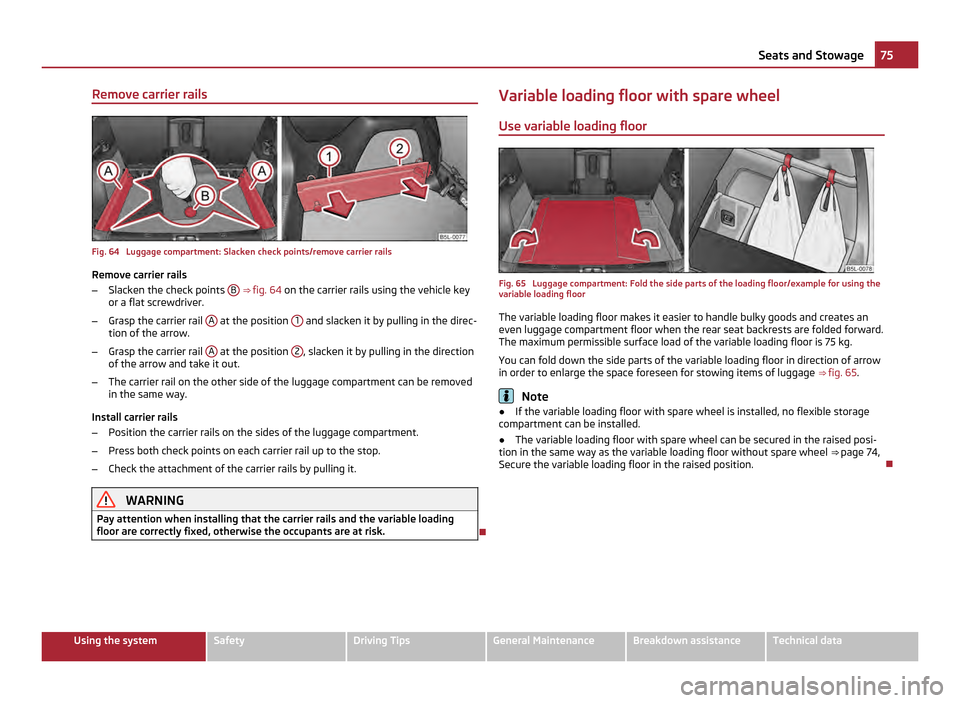
Remove carrier rails
Fig. 64 Luggage compartment: Slacken check points/remove carrier rails
Remove carrier rails
– Slacken the check points B
⇒ fig. 64 on the carrier rails using the vehicle key
or a flat screwdriver.
– Grasp the carrier rail A at the position
1 and slacken it by pulling in the direc-
tion of the arrow.
– Grasp the carrier rail A at the position
2 , slacken it by pulling in the direction
of the arrow and take it out.
– The carrier rail on the other side of the luggage compartment can be removed
in the same way.
Install carrier rails
– Position the carrier rails on the sides of the luggage compartment.
– Press both check points on each carrier rail up to the stop.
– Check the attachment of the carrier rails by pulling it. WARNING
Pay attention when installing that the carrier rails and the variable loading
floor are correctly fixed, otherwise the occupants are at risk. Variable loading floor with spare wheel
Use variable loading floor
Fig. 65 Luggage compartment: Fold the side parts of the loading floor/example for using the
variable loading floor
The variable loading floor makes it easier to handle bulky goods and creates an
even luggage compartment floor when the rear seat backrests are folded forward.
The maximum permissible surface load of the variable loading floor is 75
kg.
You can fold down the side parts of the variable loading floor in direction of arrow
in order to enlarge the space foreseen for stowing items of luggage ⇒ fig. 65 . Note
● If the variable loading floor with spare wheel is installed, no flexible storage
compartment can be installed.
● The variable loading floor with spare wheel can be secured in the raised posi-
tion in the same way as the variable loading floor without spare wheel ⇒
page 74,
Secure the variable loading floor in the raised position. 75
Seats and Stowage Using the system Safety Driving Tips General Maintenance Breakdown assistance Technical data